|
Jump Note: The
Cost to
Current eBook owners will be able to purchase that new eBook version when it appears for a very low upgrade fee, as has been our policy from the beginning. |
I'll get right to it: This is a killer camera. No sense keeping that from you right up front.
A product can be quite handsome, but if it doesn't deliver superior function, I won't let it into my life in a meaningful way. Not to go off on a rant here, but life's too short to put up with a continuous stream of shortcomings simply because a useful thing like a digital camera or other form of technology "looks good" from across the room. I once purchased one of the Minolta super-thin Dimage X cameras, and while the exterior was about as nifty as you would ever wish a piece of technology to be (many design awards can't be wrong, eh?), the images were very sub-standard. Back it went. And because I buy from local camera stores rather than from places that charge a "re-stocking fee," they cheerfully refunded my money. Same with this one, except there will be no return unless something comes up that I haven't experienced yet. Here is the new Coolpix 4500. It is the best-looking of the Nikon twist cameras that started with the CP900, CP950, CP990, CP995 and now this. Although the 9xx series seems to have become the 4xxx series (at least as long as the 4 megapixel chips are the imaging heart of a string of models) the central organizing genius of these cameras is the simple twist body that makes many angles of viewing and pointing possible. When the 950 appeared, the twist design carried over from the 900. By the 995, the swivel had evolved into a major rugged, solid, sturdy mechanical link that bridged the sections of a very logical, comfortable string of camera models.
The previous serious model, the Coolpix 5000 and coming Coolpix 5700 both use a flip out monitor screens, and while that works in many interesting ways, the 4500 is less complicated by its simpler design. Just two pieces; optical items on the left, control and monitoring items on the right. Each a handful. All the essentials housed in a neat, two-chunk package. The image is 2272 x 1704 pixels in an imager that takes up the same amount of physical space as the 3.14 megapixel imagers used in the 990/995 cameras. I find it very interesting to see how the 4-megapixel image sensor coverage stacks up to the 5-megapixel images from the premium 5xxx series. Here's a size comparison:
The camera's feature list is long and complete. Nikon took the time to renovate the menu structure and streamline a few features along the way. Gone are the Brightness +/- options, but the much more useful Contrast +/- are right where you would want them to be. Here's a quick rundown:
Have Cake. Eat Cake. Sill have Cake, Too. The CP4500 in flat mode shows its most compact configuration. Smaller, by a noticeable amount than the 950 which used to be my favorite for inside tuxedo jacket pocket storage. And the 4500 has a more tuxedo look, so that's a plus, I suppose. The zoom covers the same basic range of the 995's 4:1 zoom. Full wide is the equivalent of a 38mm lens on a 35mm film camera, and full telephoto is equal to a 152mm lens. The actual focal lengths are 7.85~32mm. Hey, that's equal to 4.08:1! Flashy Feature
Since the flash intensity is variable over a +/- 2-stop range in the menu system, I could force it to behave at the upper range of its output to test how far it would penetrate the scene. At about 16 feet from the camera, an ISO 100 shot produced an image of acceptable brightness. Boost the ISO and the flash reaches farther, just as you would expect.
Big Gold Star Award* Which brings up another point. In the past, I've moaned for years that Nikon's nomenclature could use a bit of revision in its list of factory white balance settings. The 990/995/775/5000 and others all have used the term "Fine" to mean "Daylight." This has been confusing in a minor way since Fine is also the name for a compression setting. Not any more. Now it is clearly labeled "Daylight" and earns a *BGS (Big Gold Star) from me. The 4500's white balance settings include Nikon's excellent warming/cooling feature that allows you to change the color effect slightly away from the precise factory setting for Daylight, Incandescent, Cloudy and Speedlight settings by +/- 3 units of change. Negative numbers slide the camera to a warmer look, and this can be remembered if one thinks of it as being a lower, warmer color temperature result. Color temperature is lower for indoor light bulbs and higher (bluer or cooler) for sunlight. Fluorescent light can be set to FL1, FL2 and FL3 to match the three most popular fluorescent tube colors, but as a practical matter, Auto White balance on this camera is so good that you could simply use that for all but the most precise work. Then, if you really wanted perfect color under fluorescents, you can always use the Manual white balance setting. Happy, Happy. Joy, Joy
It's a Joy Button that is a joy to work. I've seen this sort of control implemented on other devices, but for tactile feel and ergonomic ease, this earns another *BGS from me. In the space usually occupied by a simple button, Nikon has managed to implement a five-way switch that feels exactly as it should and promotes unambiguous control of functions assigned to it. Seeing/Believing In order to build this camera to this size, the viewing monitor is smaller than on previous models. It's a 1.5-inch diagonal (36mm) but it is bright and sharp. I wouldn't wish to use it for Manual focusing all the time, but it is quite bright in any sort of shade and has an anti-reflective coating on it to reduce glare. A menu item allows you to boost its back light. The optical viewfinder seems to be a bit of improvement over the one on my CP995. As you study the camera it becomes obvious that the height of the eyepiece and front element are not the same. The viewfinder is more complex than it looks to the casual gaze. Inside the camera body, it makes a zig-zag the way many binoculars and field telescopes do with prisms. It's a clever optical design that is required to zoom in perfect relationship with the camera lens. And on the camera in my hands the image in the optical viewfinder agrees well with the final result, causing a well-centered image. Of course, as with virtually all optical viewfinders, it shows you a view that is cropped into the final result, so even if you don't center your subject, the final image will have more area around the part you were aware of as you made the framing. Other 9xx and 5xxx Nikons weren't as well centered as this one. I hope that it is a trend for all future models. Another *BGS. Image How's that image? First results suggest that it has all the earmarks of current Nikon compact camera setup. Great colorimetry, good shadow detail, crisp contrast and about the same per-pixel detail of previous models. Meaning that the major pictorial difference seems to come from simply having more pixels on the page. As you can see from the flower image above, the warm rays of the nearly setting sun, the telephoto zoom setting that allows the background to blur at full aperture and the overall general impression of the shot are all working just fine. I'll shoot some test images soon to see how accurate those statements are. In the mean time, check the detailed reviews and previews from others to see how it stacks up in consensus. FX? A camera that knows how to party! The Scene modes do a lot. Portrait, Party, Night Portrait, Beach/Snow, Landscape, Sunset, Night Landscape, Museum, Fireworks, Close Up, Copy, Back Light, Multiple Exposure, Panorama Assist, Sports and Dawn/Dusk settings provide the user with good combinations of internal adjustments in anticipation of each of these. Scene settings are like whole-camera macro setups. If you understand what is contained within them, they become easy ways to accomplish complex settings. With so many (16) to choose among, it is clear that they aren't Photography 101 or Nikon Made Simple. There are at least 16 common modes to setting up a camera this versatile that make life easier if you don't have to twiddle six different ideas to achieve each mode. For fine, technically precise work you probably wouldn't use Scene modes, but that entirely depends on the situation at hand. Subject to your own approval. Nobody is putting a lens to your head threatening to shoot if you don't use them. They're clever options. Did I just rant again??
Still, that's enough to shoot the moon in tele zoom, widen back to the city at night and put that big moon in the sky over the foreground image. A minor example of the idea is pictured here. The ghost of shot #1 remains on the monitor screen as you frame shot #2 making the act of composing the two visible during the second exposure. The camera takes the second shot, shows it to you for a second or two, then thinks about what it has to do. Watch out. This mode doesn't allow a great range of exposure compensation. Shooting the moon would be better if a spot meter exposure could be used. For the example shot here, I relied on only EV+/- to assist with exposure. Also, digital zoom can throw you if you try to combine it into the idea.
Sort of a fun-house mirror trick done digitally. Photoshop does a MUCH better job of this, but P-Con certainly is useful for fun effects and rough estimates of how things might look later, back in the digital darkroom. I would suggest using it for preliminary visualization, not for final images. Preliminary Conclusions
The added features such as double exposure, panorama assist, perspective control and post-exposure verbal image notes are good, solid tools. The 4500 retains all the very highly desirable Nikon features including Continuous shooting at all sizes, BSS, Contrast control, high quality compression implementation, saturation control, monochrome shooting, a great zoom range, manual adjustment of white balance settings, a decent flash on board, easy connection to external flash units, and the undeniable usefulness of that split-body swivel design. Anybody upgrading from previous 9xx split body cameras will probably be as impressed as I am with this machine. Newcomers will find their first experience with the camera to be enhanced by the many, many options and flexibilities of operation the camera has tucked away under the hood. It's small, light, rugged, stylish, feature-packed, high quality, low cost, balanced, sensible, versatile, cleverly conceived, ergonomic and pretty, too. The design team that produced this camera goes to the head of the class. With rare exception, everything they've touched has been improved, consolidated and/or re-thought compared to the previous 9xx cameras. At last a camera from Nikon that deserves a good solid "A*" rating from my first encounters with it. Some of its features suggest it may get extra points above that. I'll continue test driving and using it and reporting here what I find. Bottom line: Nikon Coolpix 4500: A -iNova, July 19, 2002 (Updated over time) *US school grading system uses A as its top score although some teachers give A+ and the extremely rare A++ grades for exceptionally outstanding work. Many elements of this camera deserve A+ rating, but a few B's average it out as being merely excellent, as opposed to super-excellent. In other words, this is one of the rare, and well-appreciated, great digital cameras. Essays on Features: Pros and Cons of Scenes I know that Nikon is just being helpful with the 16 quick to access Scene Modes, but with 16 choices to select among, making the RIGHT choice involves a certain level of appreciation as to what each really hides beneath that simplified, iconic surface.
Night Portrait? Um, how is that different from Portrait? Museum? Does that include Theme Parks? Fireworks makes sense, but what else could it be used for? And what does Night Landscape REALLY do? Beach/Snow makes sense. "Oh, for the bright background situations." Um, isn't that what Back-Light is all about too? "Oh, that one is like Beach/Snow with FLASH! I get it." If we have Sunset and Dawn/Dusk, how come we don't have Mid-To-Late-Afternoon and Just-Before-Lunch scene modes? And no special setting for Noon? Hey, wait a minute. Here I am in the biggest Scene Mode selection process Nikon has ever made, and not one of these easy to select choices is "Normal"? You mean I have to bail OUT of Scene mode to get to Normal? Where's the fun in that? Couldn't we just have a setting that figures out the time of day, day of the year (you know, for sun angle settings) and latitude? Now Dawn/Dusk would just be a moment along a continuum from Night Landscape to Noon and back. All of this has been to build up to what I really think. And that is this: If you learn how to adjust the EV+/-, Shutter Speed, Aperture, White Balance and flash settings, you won't need at least 11 of these scene modes, but you just might make a poor choice with them due to inexperience combined with the feeling that the icons really give you good information. In order to get the most out of the Scene modes, you may have to spend 2/3 of the time you would have spent learning the essentials instead. And if you are new to digital photography, the sheer number of them makes implementation less than straightforward, which is the reason they were invented to begin with--to give the newcomer lots of help. No, you don't have to use Museum Scene Mode in Theme Parks. Put the camera in AUTO for the best average success ratio. Image Test 1 Always curious, I've begun to try to qualify the 4500 as an image capture system. A couple of surprising things have been found. Commmmpresssssssion: While the image compression seems to do just about the same per-pixel job in the 4500 as it has been doing in the previous Coolpix cameras, the wonderful phenomenon of the 5000's 3:2 mode has evaporated. What was that phenomenon, you may ask? The 5000 delivers full frame and 3:2 images on demand, as do all the major Coolpix cameras, but when shooting in 3:2 mode it delivers much more economy of file size than its 11% smaller footprint. Meaning, that depending on the compression setting you use in 3:2 mode, you can get many more shots into your CF card than just 11% more, but only with the CP5000. At BASIC compression, for instance, you can get a whopping 79% more images on the card, simply by accepting an 11% smaller shot. Sign me up! But the 4500 doesn't maintain this feature. Sigh. I knew it was too good to be true. But the weird thing is this: It usually takes MORE memory space to hold the 4500's 3:2 shot, even though it is 11% smaller than the full size (4:3 aspect) image. Huh? What the??..?!..!!! Why did I say "usually?" I've done tests that show it both ways. Sometimes it takes more memory space, and sometimes it takes less. When I figure out WHY, I'll let you know. Color: This is not definitive, but it is interesting. The 4500 in my hands does not have the same colorimetry as the 5000 I've been shooting with. This first test is nowhere near definitive, but it shows something I had been vaguely aware of in other shots. The 4500 is redder in tungsten light than the 5000. Here's a roll-over that shows the difference even after Photoshop had been used with each image to "neutralize the grays" in the art piece. It's a "rollover" shot of a Barry Kite print, and each camera was set to Tungsten (Incandescent in the WB list), ISO 100, Manual exposure of 1/2 sec, f/7.6 and f/7.8, NR engaged (due to the long shutter speed and small f-stops) all on a tripod with the self-timer tripping the shutter. Move your mouse onto the image to show the CP5000. No mouse = CP4500. The hard part about setting up this shot was getting the same image-per-pixel size in the camera. In order to do that, I had to zoom farther into the scene with the 4500 than with the 5000. There were more pixels in the 5000's shot, but only out at the edges. Both images are exactly 1:1 here. 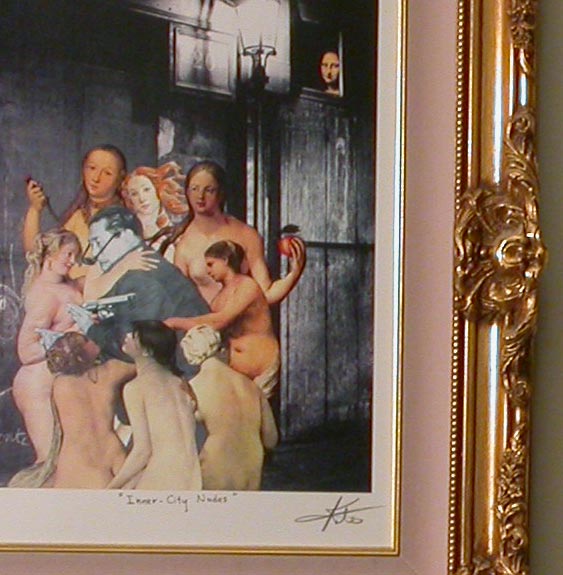 Sorry about the miss-registration. The 4500 was sitting literally on top of the 5000. Detail in these 1:1 slices confirm that the PER-PIXEL detail is virtually identical. Check the Kite signature, for instance. While there are some detail differences in things like the specular highlights, the color jump is the Big Difference. Since the neutral parts of the Kite image contained some degree of tint in each, I've used Photoshop Curves control to sample the same gray area of each into colorlessness. Still, the characteristic warmer--in fact redder--results of the 4500 show as obvious. Nikon has either changed the colorimetry or one of these cameras is either plus red or plus green! Now I'm wondering what Daylight and Manual White Balance shots will bring. Stay tuned. Don't just take my word for it! Read the reviews and previews from the digital camera testers:
|
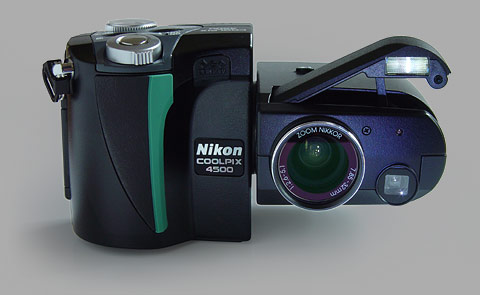 I'm a design freak and
a great appreciator of well-executed ergonomics, control interfaces,
logic and functionality. Style counts with me, too, but it doesn't
dominate my judgment when it comes to a tool that is designed
to be used.
I'm a design freak and
a great appreciator of well-executed ergonomics, control interfaces,
logic and functionality. Style counts with me, too, but it doesn't
dominate my judgment when it comes to a tool that is designed
to be used.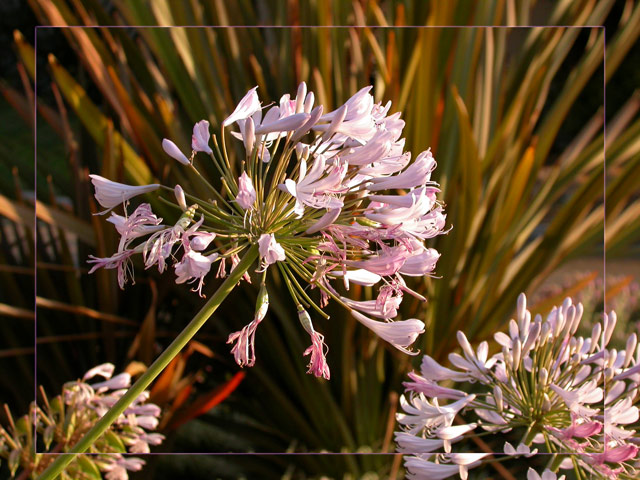
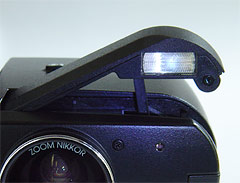 The
on-camera flash pops up when needed automatically. A support
arm crosses the top of the optical section and lifts what looks
like the world's smallest flash head up out of the extreme left
top part of the body. A window about 0.5 x 0.25 inches (13 x
8 mm) is all the surface there is for emitting light. The whole
arm that lifts out of the case is itself only half of an inch
wide and a small circular feature at the extreme end of the flash
arm houses the flash sensor.
The
on-camera flash pops up when needed automatically. A support
arm crosses the top of the optical section and lifts what looks
like the world's smallest flash head up out of the extreme left
top part of the body. A window about 0.5 x 0.25 inches (13 x
8 mm) is all the surface there is for emitting light. The whole
arm that lifts out of the case is itself only half of an inch
wide and a small circular feature at the extreme end of the flash
arm houses the flash sensor.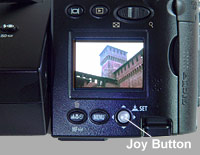 Selecting
things in the menu of the 4500 is facilitated by a new type of
button on this Nikon. It's a miniature joystick of sorts that
takes up very little space on the back of the camera under the
monitor. It moves horizontally and vertically to scroll through
things or slide around within enlarged review images, but it
also pushes inward to confirm certain selections.
Selecting
things in the menu of the 4500 is facilitated by a new type of
button on this Nikon. It's a miniature joystick of sorts that
takes up very little space on the back of the camera under the
monitor. It moves horizontally and vertically to scroll through
things or slide around within enlarged review images, but it
also pushes inward to confirm certain selections.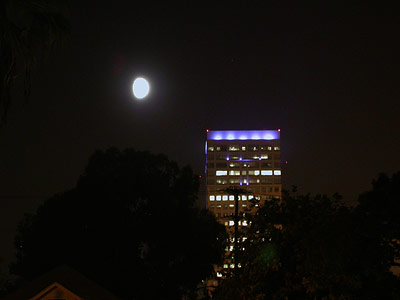 The
eventual eBook chapter about this camera will get into deep detail
as to what each does, but some highlights are here:
The
eventual eBook chapter about this camera will get into deep detail
as to what each does, but some highlights are here: Copy scene sets the camera
to instant B&W. In non-scene mode the same thing can be accessed
but the scene mode turns the speedlight off, presumably so whatever
you are "copying" wouldn't get the glare of a camera
flash. So Copy scene is really non-flash B&W.
Copy scene sets the camera
to instant B&W. In non-scene mode the same thing can be accessed
but the scene mode turns the speedlight off, presumably so whatever
you are "copying" wouldn't get the glare of a camera
flash. So Copy scene is really non-flash B&W.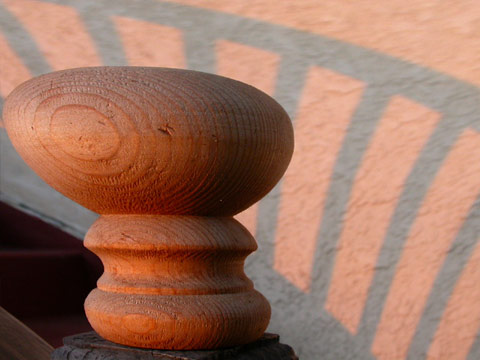 As
a feature it's a mixed blessing. The control range is wide but
the implementation is not perfect. From these shots, you can
see the extreme effect it can have on an image that didn't need
perspective control. Nice to know that the in-camera effect has
such a wide range of adjustment.
As
a feature it's a mixed blessing. The control range is wide but
the implementation is not perfect. From these shots, you can
see the extreme effect it can have on an image that didn't need
perspective control. Nice to know that the in-camera effect has
such a wide range of adjustment.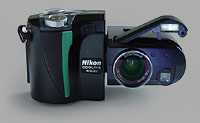 The
layout and functionality of this camera is decidedly superior
to all previous Coolpix models I've used. No exaggeration. I
have yet to open up the manual, and experience from previous
models has gotten me this far without confusion. Nikon's manuals
have been getting better over the past several models, so I'll
see what secrets hide within it.
The
layout and functionality of this camera is decidedly superior
to all previous Coolpix models I've used. No exaggeration. I
have yet to open up the manual, and experience from previous
models has gotten me this far without confusion. Nikon's manuals
have been getting better over the past several models, so I'll
see what secrets hide within it.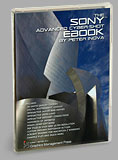
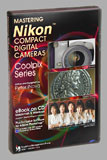
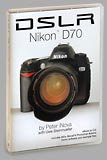 Get the eBooks
Get the eBooks